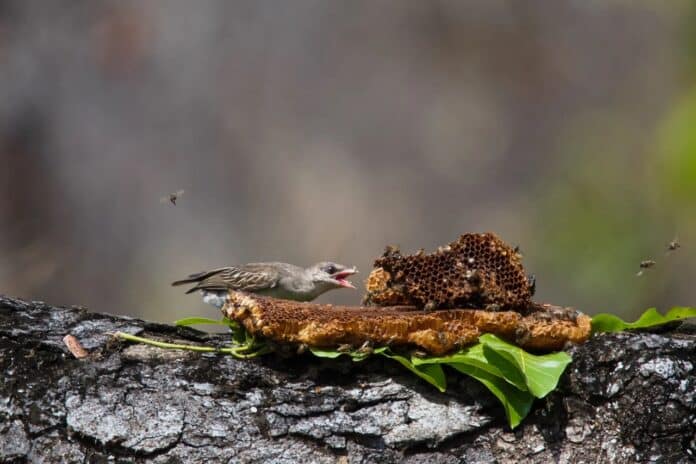Honeyguides in Africa lead tourists to bee nests, harvest honey, and make beeswax and larvae available. A comparable cooperative relationship between honeyguides and honey badgers (Mellivora capensis) is frequently claimed. However, the evidence still needs to be provided. This collaboration may impact the origins of honeyguide cooperation and the ecology and conservation of honey badgers and honeyguides.
A study supported by the University of Cambridge and Cape Town, which included researchers from nine African countries, sought proof of the relationship between honeyguide birds and honey badgers.
The researchers conducted over 400 interviews with honey hunters across Africa, discovering that while honeyguide birds have been directed to honeybees’ nest’s thousands of times, they have yet to witness a bird and a badger interacting to find honey. The vast majority (80%) of the 11 villages polled have spent centuries searching for wild honey, including with the assistance of honeyguide birds.
Dr. Jessica van der Wal, University of Cape Town, lead author of the study, said, “It’s well-established that honeyguides lead humans to bees’ nests, but evidence for bird and badger cooperation in the literature is patchy.”
She added, “It tends to be old, second-hand accounts of someone saying what their friend saw. So we decided to ask the experts directly.”
Most communities surveyed were doubtful that honeyguide birds and honey badgers help each other access honey, and the majority (80%) had never seen the two species interact.
However, three communities in Tanzania stood out, where many people said they had seen honeyguide birds and honey badgers cooperating to get honey and beeswax from bees’ nests. Sightings were most common amongst the Hadzabe honey-hunters, of which 61% said they had seen the interaction.
Dr. Brian Wood from the University of California, Los Angeles, who co-authored the study, said, “Hadzabe hunter-gatherers quietly move through the landscape while hunting animals with bows and arrows, so are poised to observe badgers and honeyguides interacting without disturbing them. Over half of the hunters reported witnessing these interactions on rare occasions.”
The researchers reconstructed the procedures required for honeyguide birds and honey badgers to collaborate, demonstrating that some phases, such as the bird seeing and approaching the badger, are feasible.
Others, such as the honeyguide talking to the badger and the badger following it to a bee’s nest, are unknown. Badgers have weak hearing and vision, which makes following a chattering honeyguide bird difficult.
According to the researchers, only select Tanzanian honey badger populations have evolved the abilities and knowledge required to work with honeyguide birds, and these skills are passed down from generation to generation. It’s also possible that badgers and birds coexist in other parts of Africa but have yet to be sighted.
The meeting is difficult to see due to the muddled effect of human presence: spectators are still determining whether the honeyguide bird is speaking to them or the badger.
The researchers emphasize the importance of more scientists engaging with relevant communities, learning from their perspectives and observations, and integrating scientific and cultural knowledge to enrich and speed up research.
The greater honeyguide bird, the Indicator indicator, is well-known to communities across many African countries, where it has been used for generations to find bees’ nests.
Wild honey is a high-energy food that can provide up to 20% of calorie intake, and the wax that hunters share or discard is a valuable food for the honeyguide.
Humans have learned how to read the calls and behavior of the honeyguides to find wild bees’ nests, and humans call back – it’s a kind of conversation as they move through the landscape toward the bees’ nests.
Humans are useful companions to honeyguides because of our mastery of fire and tools. However, honey badgers, Mellivora capensis, are more likely to annoy the bees, and aggressive bees can kill the birds.
Spottiswoode said, “Some have speculated that the guiding behavior of honeyguides might have evolved through interactions with honey badgers, but then the birds switched to working with humans when we came on the scene because of our superior skills in subduing bees and accessing bees’ nests. It’s an intriguing idea but hard to test.”
Journal Reference:
- H. A. Isack, J. I. Ibrahim et al. Do honey badgers and greater honeyguide birds cooperate to access bees’ nests? Ecological evidence and honey-hunter accounts.Journal of Zoology DOI: 10.1111/jzo.13093
